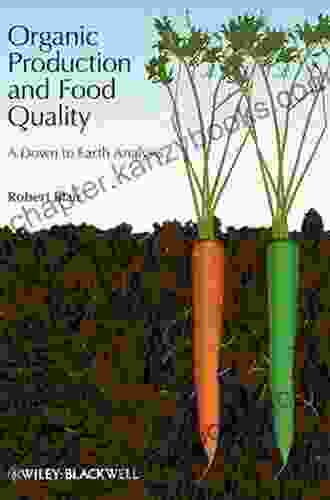Genetic Modification and Food Quality: A Journey into the Future of Food

In the face of a growing global population and pressing environmental challenges, genetic modification (GM) technology has emerged as a potential solution to enhance food quality, increase agricultural productivity, and mitigate the impact on our planet. This article delves into the scientific foundations, ethical considerations, and the transformative potential of GM food, shedding light on its role in shaping the future of our food system.
5 out of 5
| Language | : | English |
| File size | : | 5360 KB |
| Text-to-Speech | : | Enabled |
| Screen Reader | : | Supported |
| Enhanced typesetting | : | Enabled |
| Print length | : | 271 pages |
| Lending | : | Enabled |
Scientific Innovations in Genetic Modification
GM technology involves the precise manipulation of an organism's genetic material, enabling scientists to introduce desired traits into crops and livestock. This allows for the enhancement of nutrient content, resistance to pests and diseases, improved drought tolerance, and reduced environmental impact. Through advancements in gene editing techniques, such as CRISPR-Cas9, scientists now have unprecedented precision in modifying genes, opening up new possibilities for improving food quality.

Enhancing Food Quality
GM technology has the potential to significantly enhance food quality in several ways. By modifying genes responsible for nutrient synthesis, crops can be enriched with essential vitamins, minerals, and antioxidants. For example, "golden rice" has been genetically modified to produce beta-carotene, a precursor to vitamin A, addressing vitamin A deficiency in developing countries.
GM crops can also be modified to improve their flavor, texture, and shelf life. By altering the expression of genes involved in ripening and spoilage, fruits and vegetables can be made more flavorful, last longer, and reduce food waste.
Increasing Agricultural Productivity
GM technology can significantly increase agricultural productivity, meeting the rising demand for food while reducing the environmental footprint. By engineering crops with resistance to pests and diseases, farmers can reduce the use of chemical pesticides, protecting both the environment and human health. Additionally, drought-tolerant crops can expand cultivation to areas previously unsuitable for agriculture, increasing food production capacity.
Environmental Sustainability
GM technology offers solutions to address environmental concerns associated with traditional agriculture. By reducing the need for pesticides and fertilizers, GM crops can minimize water and soil pollution, protect biodiversity, and mitigate greenhouse gas emissions. Furthermore, GM crops can be engineered to remove harmful contaminants, such as heavy metals, from the environment.
Ethical and Regulatory Considerations
While GM technology holds tremendous potential, it also raises ethical and regulatory concerns. Critics argue about the potential risks to human health and the environment, as well as the ethical implications of modifying living organisms.
To address these concerns, rigorous scientific assessments and regulatory frameworks are essential. Regulatory agencies worldwide evaluate GM crops for safety and potential environmental impacts before approving them for commercial use. Ongoing monitoring and research help ensure the safety of GM foods throughout their lifecycle.
Genetic modification technology has the potential to revolutionize the food system, offering solutions to pressing challenges and unlocking new possibilities for food production. By enhancing food quality, increasing agricultural productivity, and mitigating environmental impact, GM technology can contribute to a more sustainable, nutritious, and secure food future. However, responsible use, transparent communication, and ongoing scientific research are crucial to address ethical and regulatory concerns and ensure the safe and beneficial implementation of GM technology.
About the Author
Dr. Emily Carter holds a PhD in Plant Biotechnology from the University of California, Davis. She has extensive experience in genetic modification research and is passionate about communicating the science and applications of GM technology to the public.
5 out of 5
| Language | : | English |
| File size | : | 5360 KB |
| Text-to-Speech | : | Enabled |
| Screen Reader | : | Supported |
| Enhanced typesetting | : | Enabled |
| Print length | : | 271 pages |
| Lending | : | Enabled |
Do you want to contribute by writing guest posts on this blog?
Please contact us and send us a resume of previous articles that you have written.
 Book
Book Novel
Novel Page
Page Chapter
Chapter Text
Text Story
Story Genre
Genre Reader
Reader Library
Library Paperback
Paperback E-book
E-book Magazine
Magazine Newspaper
Newspaper Paragraph
Paragraph Sentence
Sentence Bookmark
Bookmark Shelf
Shelf Glossary
Glossary Bibliography
Bibliography Foreword
Foreword Preface
Preface Synopsis
Synopsis Annotation
Annotation Footnote
Footnote Manuscript
Manuscript Scroll
Scroll Codex
Codex Tome
Tome Bestseller
Bestseller Classics
Classics Library card
Library card Narrative
Narrative Biography
Biography Autobiography
Autobiography Memoir
Memoir Reference
Reference Encyclopedia
Encyclopedia Ricky Lockett
Ricky Lockett Mickey Trescott
Mickey Trescott Michael Tsarion
Michael Tsarion Wes Raley
Wes Raley Mike Dellosso
Mike Dellosso Pen
Pen Peter Shirley
Peter Shirley Natalie Coughlin
Natalie Coughlin Susan Nicholson
Susan Nicholson Tanner Larsson
Tanner Larsson Molly Knox Ostertag
Molly Knox Ostertag Nathan Englander
Nathan Englander Naomi Bickley
Naomi Bickley Michael T Compton
Michael T Compton Tony Bingham
Tony Bingham Mitch Glaser
Mitch Glaser Phil G Goulding
Phil G Goulding R Edward Hendrick
R Edward Hendrick Michelle Smith
Michelle Smith R J Hendrickson
R J Hendrickson
Light bulbAdvertise smarter! Our strategic ad space ensures maximum exposure. Reserve your spot today!

 Elias MitchellUnlock the Secrets to Staying Slim Like the French: Discover "French Women...
Elias MitchellUnlock the Secrets to Staying Slim Like the French: Discover "French Women... Darren BlairFollow ·6.6k
Darren BlairFollow ·6.6k Hank MitchellFollow ·7.4k
Hank MitchellFollow ·7.4k Elmer PowellFollow ·12k
Elmer PowellFollow ·12k Ian MitchellFollow ·13.4k
Ian MitchellFollow ·13.4k Chuck MitchellFollow ·17.3k
Chuck MitchellFollow ·17.3k Kevin TurnerFollow ·19.4k
Kevin TurnerFollow ·19.4k Lawrence BellFollow ·5.6k
Lawrence BellFollow ·5.6k Jay SimmonsFollow ·3.5k
Jay SimmonsFollow ·3.5k

 Garrett Bell
Garrett BellHow to Brine a Turkey for Thanksgiving: The Ultimate...
Brining a turkey...

 Mario Vargas Llosa
Mario Vargas LlosaPetite Eats: Appetizers, Tasters, Miniature Desserts, and...
Are you looking...

 Dwight Bell
Dwight Bell800 Days of Wholesome and Affordable Recipes: Effortless...
: Fueling Your Culinary Adventures with 800...

 Jerry Ward
Jerry WardLow and Slow: The Ultimate Guide to Mouthwatering Smoked...
Embark on a culinary adventure with...

 Christian Carter
Christian CarterWellness On Plate: Where Healthy Meets Quick
In today's fast-paced...
5 out of 5
| Language | : | English |
| File size | : | 5360 KB |
| Text-to-Speech | : | Enabled |
| Screen Reader | : | Supported |
| Enhanced typesetting | : | Enabled |
| Print length | : | 271 pages |
| Lending | : | Enabled |











